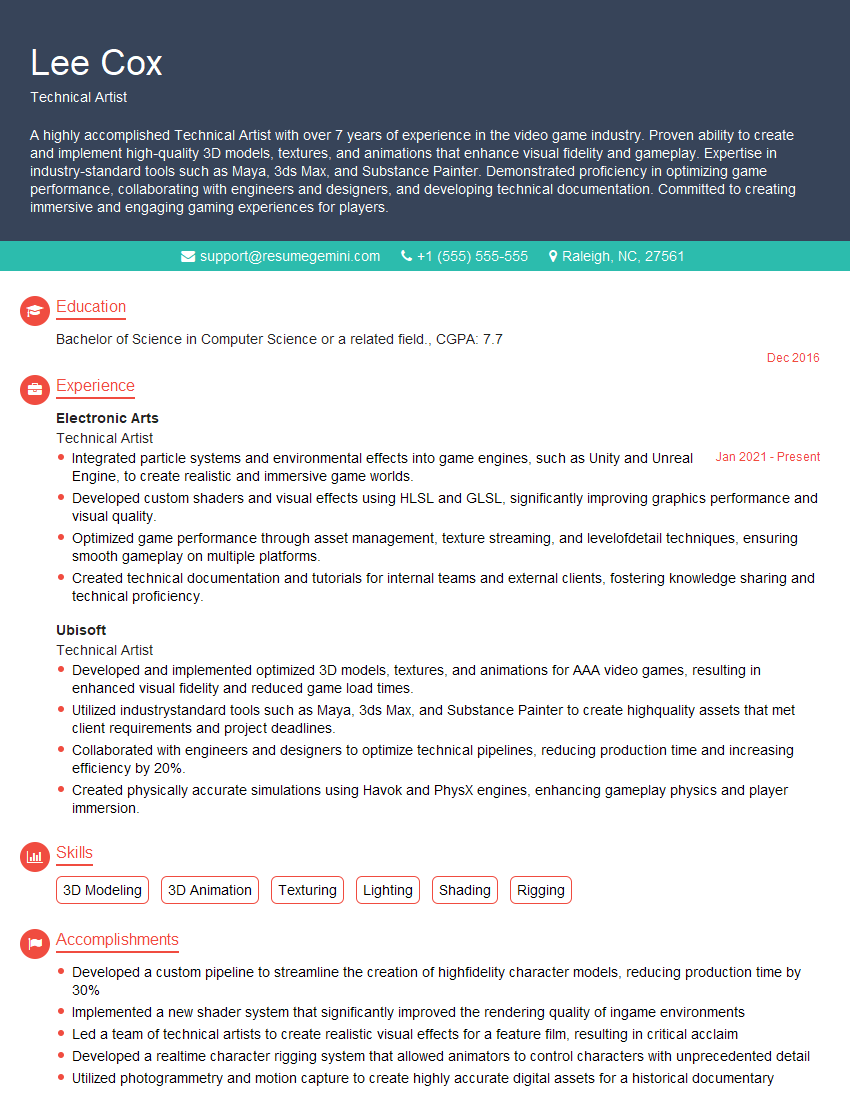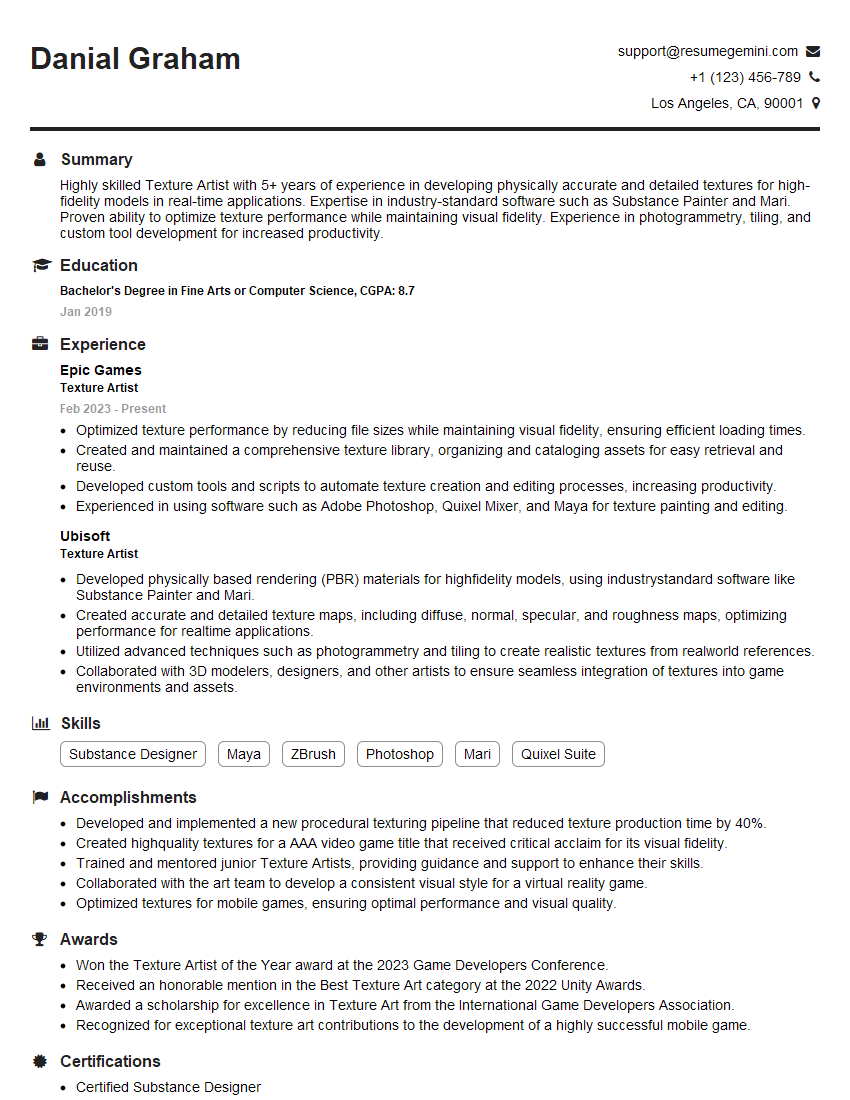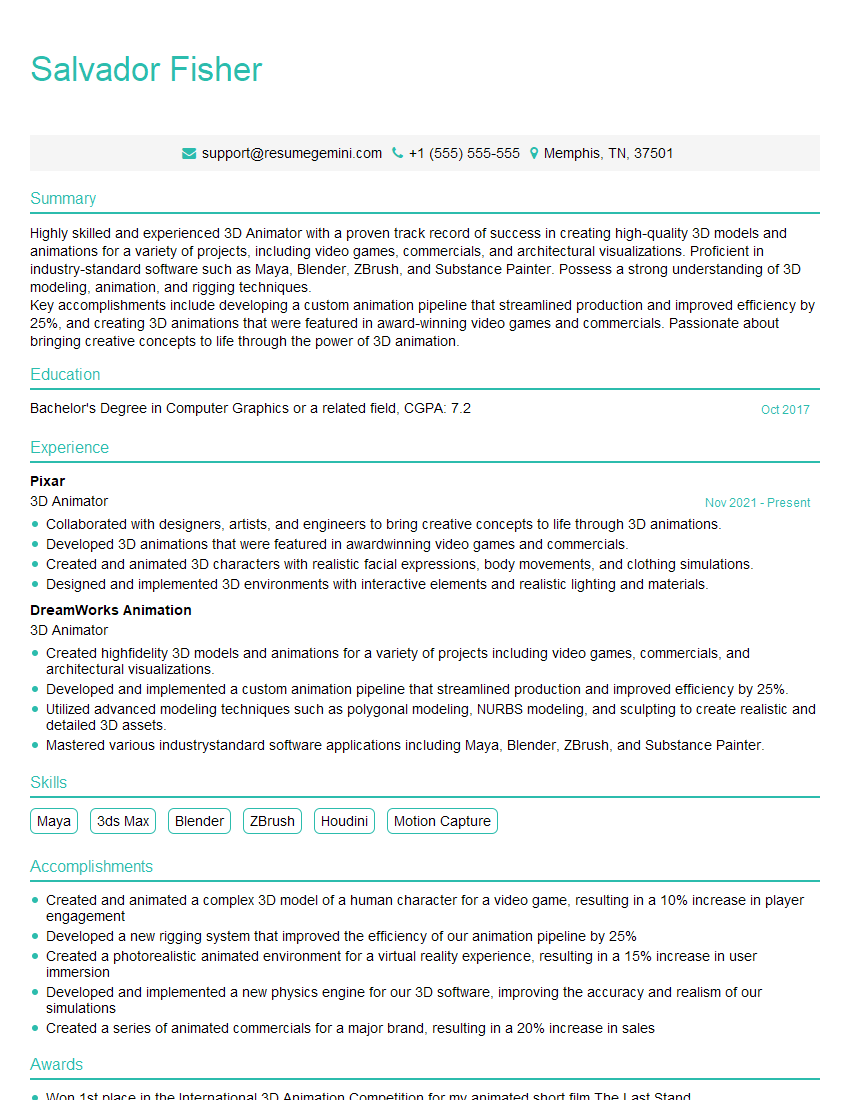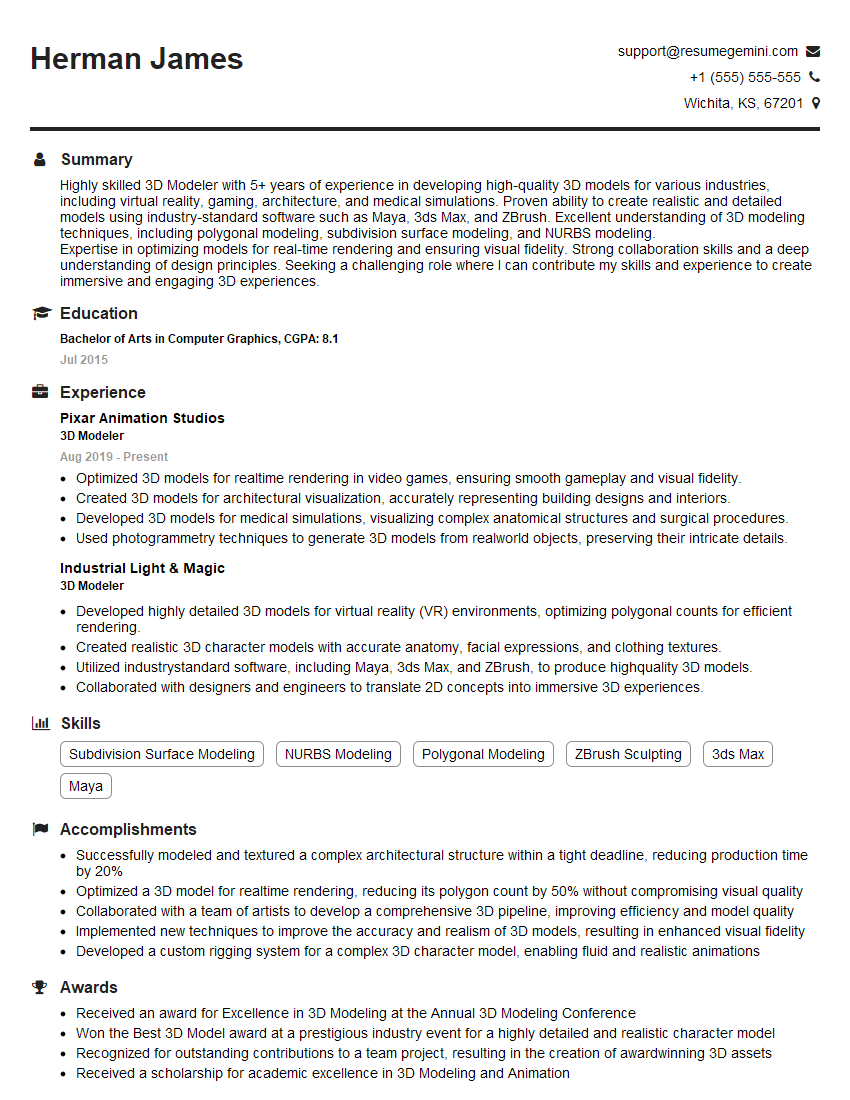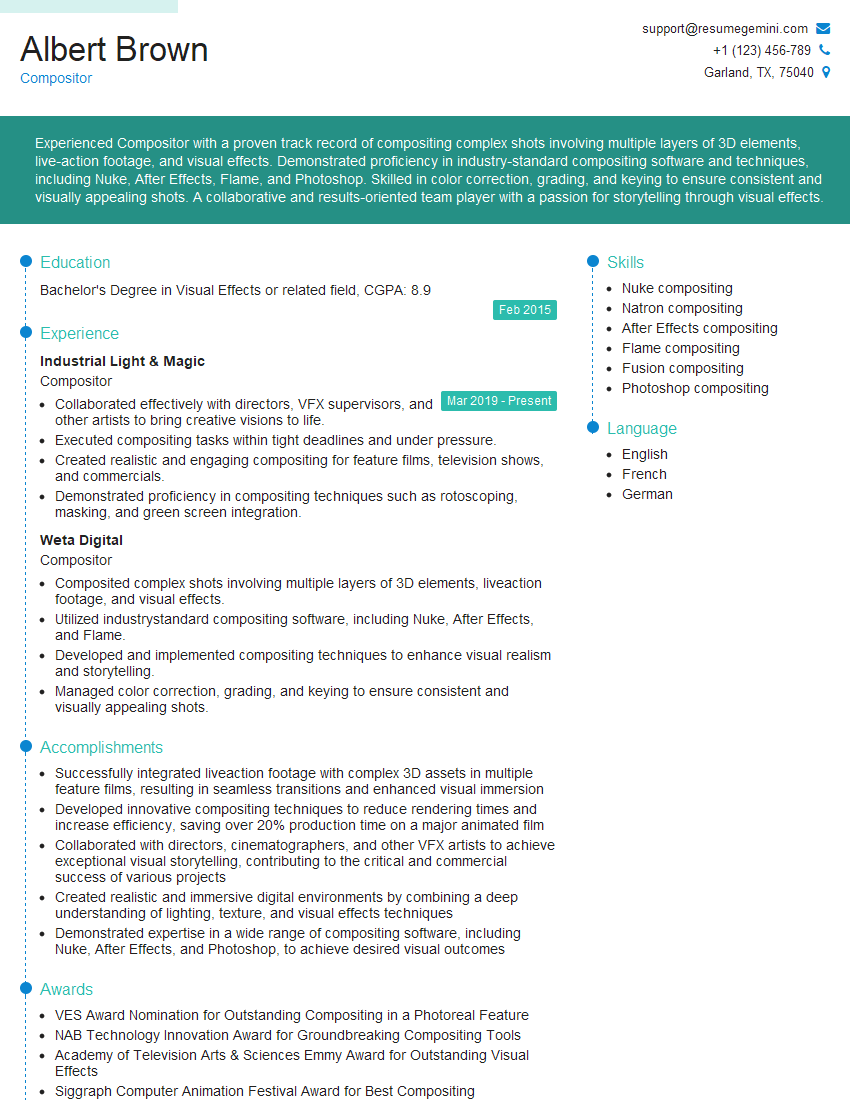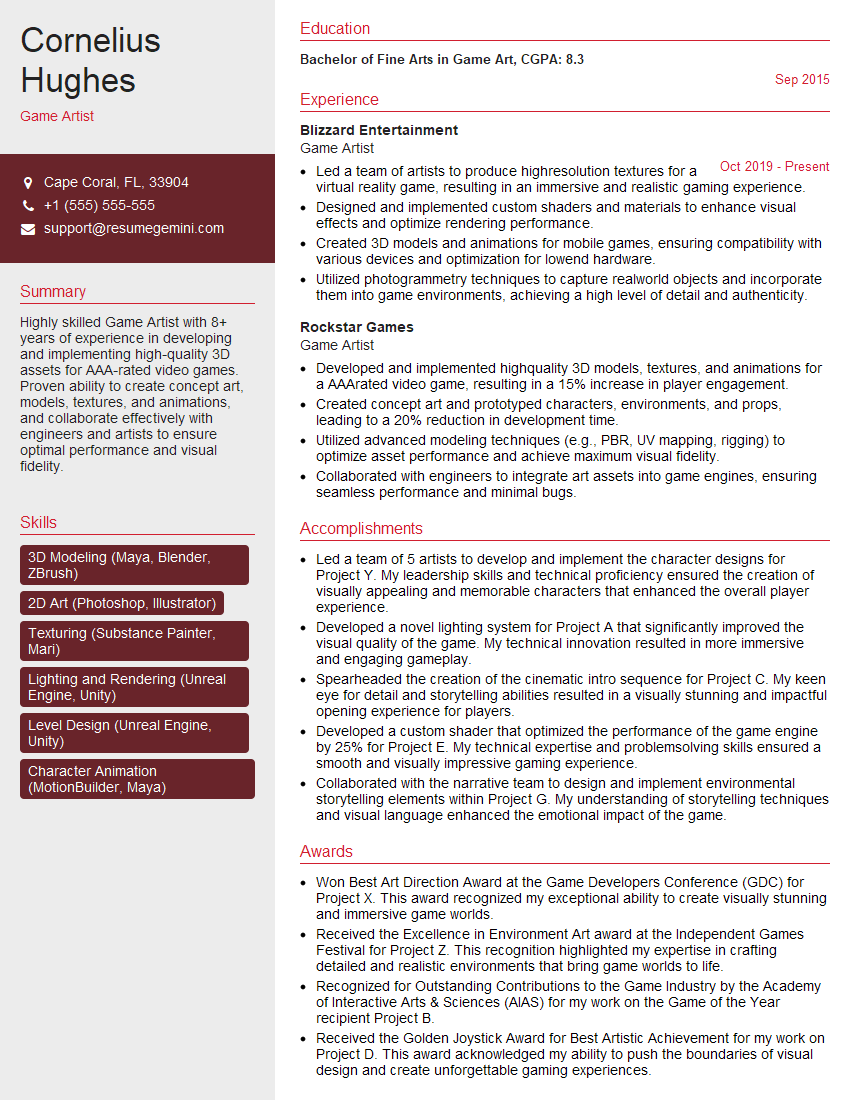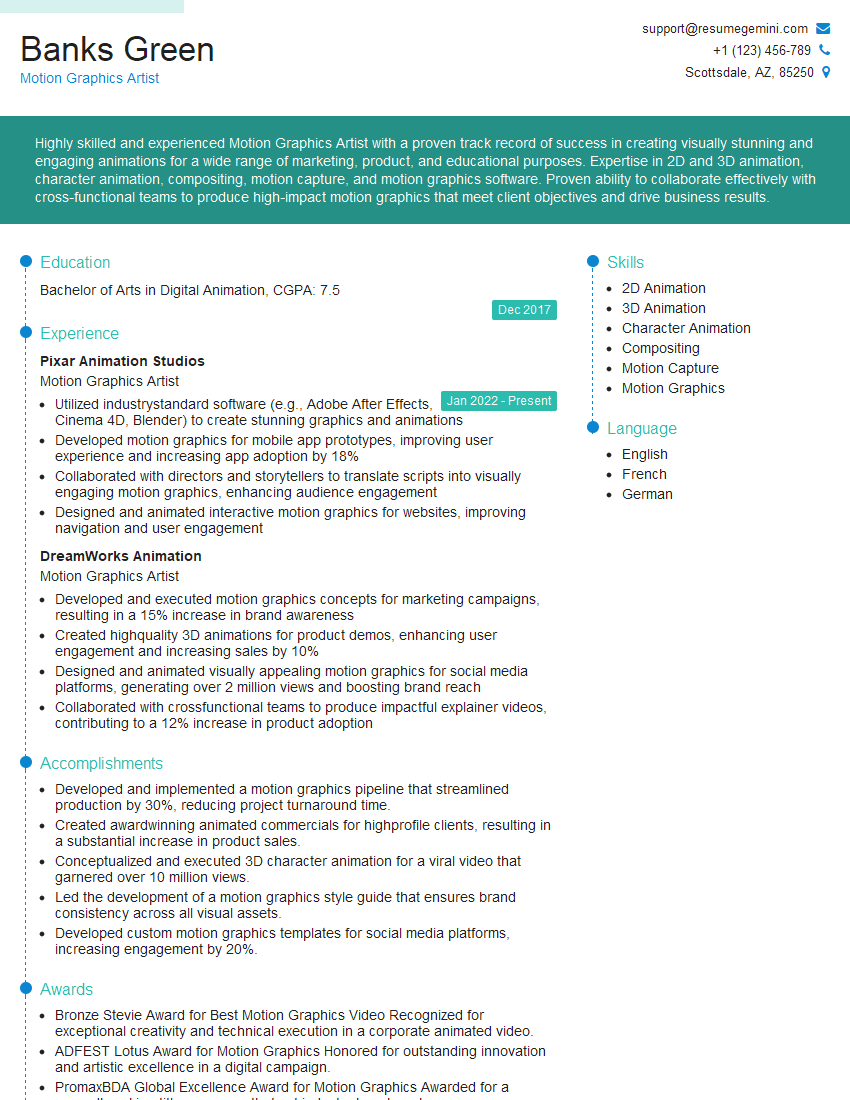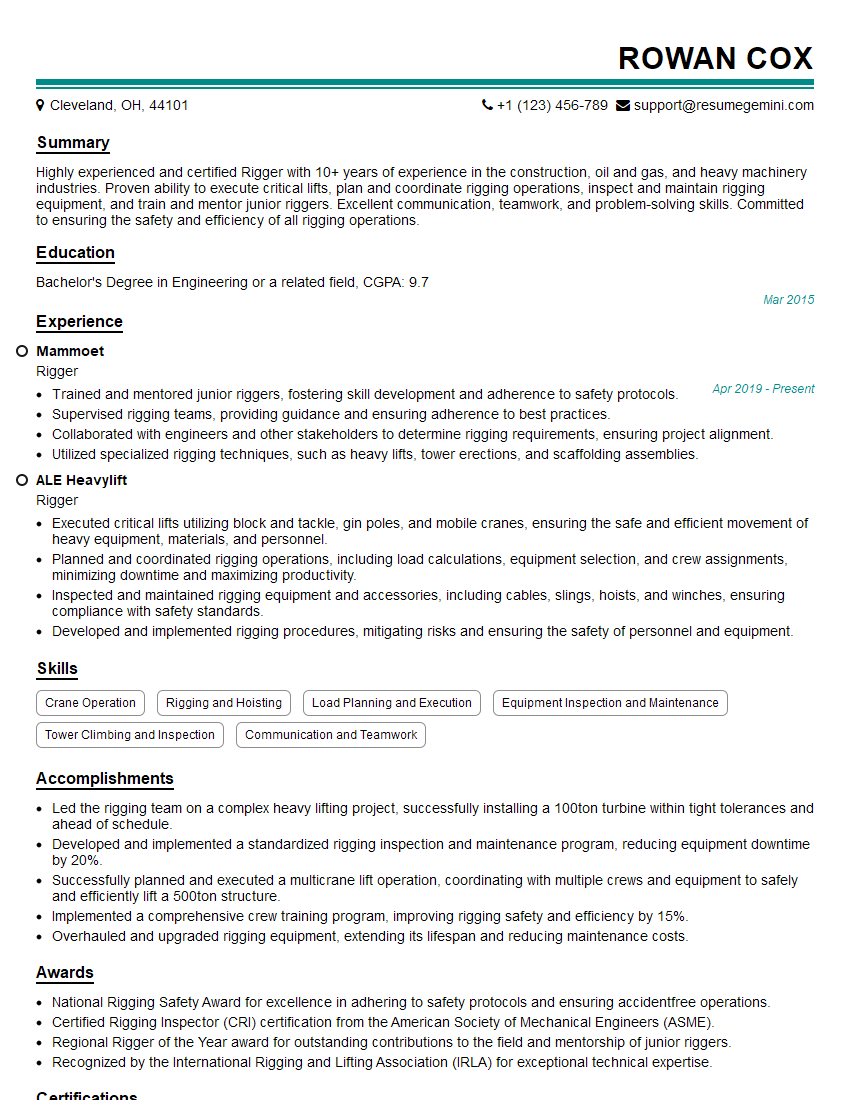Unlock your full potential by mastering the most common 3D Modeling and Animation Software Proficiency interview questions. This blog offers a deep dive into the critical topics, ensuring you’re not only prepared to answer but to excel. With these insights, you’ll approach your interview with clarity and confidence.
Questions Asked in 3D Modeling and Animation Software Proficiency Interview
Q 1. Explain your experience with ZBrush sculpting techniques.
ZBrush is my go-to for sculpting high-poly models, offering unparalleled detail and control. My experience spans a wide range of techniques, from basic clay buildup to advanced features like ZRemesher and DynaMesh. I frequently employ a combination of these techniques. For instance, I might start with a base mesh, then use DynaMesh to quickly adjust the overall form, refining details with various brushes like the Standard brush for broad shapes and the Clay Buildup brush for subtle modeling. Later, I’d use ZRemesher to reduce the polygon count for efficient retopology in other software. I’m proficient in using masking and sculpting with different brush strengths and alphas to achieve intricate details like wrinkles, pores, and muscle definition. One project I worked on involved sculpting a highly detailed dragon, where I used ZBrush’s powerful sculpting tools to achieve realistic scales and intricate wing membranes.
For example, when sculpting a character’s face, I begin with a basic sphere, then gradually add features using various brushes and techniques. I pay attention to anatomical accuracy, referencing real-life photographs or anatomical charts, ensuring the proportions and musculature are believable.
Q 2. Describe your workflow for creating realistic human skin textures in Substance Painter.
Creating realistic human skin textures in Substance Painter involves a layered approach focusing on subtle variations and details. I begin by creating a base color layer, often using a photo of real skin as a reference for accurate color and subsurface scattering. Then, I add layers for different aspects of the skin, such as pores, wrinkles, blemishes, and scars. I use different types of masks to control where each effect applies. For instance, a normal map is used to add depth to the pores, a height map adds surface detail. I might use a dirt layer to simulate the accumulation of grime in skin crevices. Subtle variations are crucial to realism; I adjust the opacity and blending modes of each layer to create a natural look, avoiding harsh contrasts.
Importantly, I use layers for different levels of detail (LODs). This allows me to create high-resolution textures for close-ups and lower-resolution versions optimized for different game engine requirements. I often experiment with different filter effects to create unique textures. For instance, I might use a noise filter to create a subtle variation in skin tone, simulating freckles or birthmarks. For example, while working on a character for a video game, I created high-resolution skin textures with multiple layers to create a detailed and believable look for close-ups.
Q 3. How do you optimize 3D models for game engines like Unity or Unreal Engine?
Optimizing 3D models for game engines like Unity or Unreal Engine is critical for performance. The key is to balance visual fidelity with draw call efficiency. This involves several strategies:
- Polygon Reduction: High-poly models are usually decimated (reduced in polygon count) using tools like ZRemesher in ZBrush or similar tools within Maya or Blender. The goal is to reduce the polygon count while maintaining the model’s shape.
- Texture Optimization: High-resolution textures can strain GPU performance. I optimize textures by reducing their resolution, ensuring they are appropriately sized for their intended use within the game. Techniques like normal mapping, parallax mapping, and ambient occlusion maps are crucial to maintaining detail without excessively high-resolution diffuse maps.
- Mesh Optimization: Techniques like level of detail (LOD) systems are essential. These systems load simpler versions of the model from a distance, maintaining performance without compromising the visual fidelity of close-up objects.
- Material Optimization: Using efficient shaders and optimizing material properties can drastically impact performance. This often involves simplifying the material’s complexity without losing critical visual details.
- Draw Call Reduction: Combining similar meshes and materials into larger groups minimizes the number of draw calls the GPU needs to make, improving performance significantly.
For example, I recently optimized a detailed city model for a mobile game by using LODs, reducing polygon count, and compressing textures. The result was a significant increase in game performance without compromising the visual appeal.
Q 4. What are the differences between keyframing and procedural animation?
Keyframing and procedural animation are two fundamentally different approaches to animating 3D models. Keyframing is a manual process where you set specific poses (keyframes) at various points in time. The software interpolates between these poses to create the animation. It’s like drawing individual frames in a flipbook. Procedural animation, on the other hand, utilizes algorithms and rules to generate animation automatically. This might involve scripting or using built-in physics simulations. Imagine instead of drawing each frame, you write a script that tells the computer how to move the character based on certain principles.
Keyframing offers precise control, but it’s time-consuming, especially for complex animations. Procedural animation is quicker and can create natural-looking movement, but it may require specialized skills in scripting and may not always provide the fine-grained control offered by keyframing. Often, a combination of both techniques is used for optimal results.
For example, I might keyframe facial expressions of a character for a cutscene, while using procedural animation for subtle movements of their clothing or hair.
Q 5. Explain your understanding of normal maps and their application in rendering.
Normal maps are texture maps that store surface normal information, essentially simulating surface detail without increasing the polygon count. They provide information about the direction of the surface normal at each point of a 3D model. This information influences how light interacts with the surface, creating the illusion of bumps and grooves. Think of it as a shortcut to visual detail. The renderer uses the normal map to determine how light reflects off the surface, generating realistic shading and highlighting, creating the illusion of detail without requiring the extra polygons. This is crucial for real-time rendering in games.
In rendering, a normal map is applied to a low-polygon model. The renderer then uses the data in the normal map to calculate lighting, making the low-poly model appear to have the much higher polygon detail of the high-poly model that it’s based on. This significantly reduces rendering overhead while maintaining visual fidelity.
Q 6. How do you troubleshoot rendering issues in a 3D application like Maya or Blender?
Troubleshooting rendering issues in applications like Maya or Blender often involves a systematic approach. First, I identify the nature of the problem: is it a lighting issue, a texture problem, a geometry issue, or something else? Then, I would focus on the area of the issue by going through the following steps.
- Check Render Settings: Ensure the render settings (resolution, sampling rate, rendering engine) are appropriate for the scene’s complexity. Insufficient samples often lead to noise.
- Verify Textures and Materials: Confirm that all textures are correctly assigned and have the right paths. Examine material settings for issues that might cause unexpected rendering behavior.
- Inspect Geometry: Look for any issues with the model’s geometry, such as overlapping faces, flipped normals, or non-manifold geometry that could cause rendering artifacts.
- Lighting Analysis: Examine lighting setups. Incorrect light settings can lead to unexpected results. Look for possible problems in the lighting system, which could cause dark spots, too much glow, or overall issues in the scene.
- Isolate Problems: To narrow down the issue, I often render small portions of the scene to determine if the problem is isolated to a specific object or area.
- Check Render Logs: Review the application’s render logs for error messages or warnings that can indicate the source of the problem.
For example, while rendering a scene I encountered unexpected dark areas. By carefully examining the lighting setup and looking at the rendering logs, I was able to identify that a shadow was blocking the entire area instead of only part of the scene, which led me to find a small adjustment needed in the scene’s light settings.
Q 7. What are your preferred methods for creating believable character rigging?
Creating believable character rigging involves a blend of art and technical skill. My preferred methods prioritize a balance between anatomical accuracy and animation efficiency. I typically start by creating a detailed base skeleton using a skeletal hierarchy that mirrors the character’s anatomy as closely as possible. This allows for more natural and realistic movement. Then, I use joint chains to simulate the movement of different body parts. It helps to pay particular attention to the joints that connect different parts of the body, for example, the shoulder, elbow, and wrist should all be positioned correctly in order to create a natural movement in the arm.
I often use constraints to control complex movements. Inverse kinematics (IK) handles allow for easier and more intuitive pose manipulation. Forward kinematics (FK) might be used for fine-tuned control of specific body parts. I use various techniques like skin weighting and deformation methods (such as blendshapes) to connect the mesh to the skeleton seamlessly and ensure that there are no deformities or glitches when moving the model. I always perform thorough tests and iterative adjustments to fine-tune the rig’s performance and achieve believable animations.
For example, while working on a character animation, I used a combination of FK and IK, along with custom constraints, to perfectly create the delicate movements of a character’s hand playing the piano, ensuring the fingers moved naturally without clipping or other rigging issues.
Q 8. Describe your experience with different lighting techniques (e.g., global illumination, ray tracing).
Lighting is crucial for establishing mood, realism, and visual appeal in 3D. I’m proficient in various techniques, including global illumination and ray tracing. Global illumination simulates how light bounces around a scene, creating realistic indirect lighting effects like ambient occlusion and color bleeding. Think of it like the subtle shadows and light reflections you see in a real room – not just from the direct light source but also from surfaces reflecting light onto each other. I’ve used this extensively in architectural visualizations to create a sense of depth and realism, for instance, simulating how sunlight filters through a window and illuminates the interior.
Ray tracing, on the other hand, is a more computationally intensive method that simulates the path of individual light rays. This results in highly realistic reflections, refractions, and shadows. I’ve used ray tracing to create stunning product renders, where the precise reflection of light on a polished surface is critical for conveying its quality and texture. For example, I rendered a jewelry piece using ray tracing, meticulously capturing the sparkle of the diamonds and the reflection of the surrounding environment.
I’m also experienced with other techniques like baked lighting (pre-calculated lighting for optimized real-time rendering), image-based lighting (using HDR images to light a scene realistically), and physically-based rendering (PBR), which aims for accurate light interaction with materials based on real-world physics.
Q 9. How familiar are you with version control systems like Git or Perforce?
Version control is essential for collaborative projects and managing revisions. I’m highly proficient with Git and have worked extensively with Perforce in larger studio environments. Git’s distributed nature makes it ideal for individual projects and smaller teams, allowing for easy branching and merging of code. I regularly use Git for personal projects and smaller client jobs, utilizing features like branching for experimentation and pull requests for collaborative feedback. My workflow typically involves committing changes frequently with descriptive commit messages, making it easy to track progress and revert to previous versions if needed.
Perforce, on the other hand, is better suited for large-scale collaborative projects with many artists working simultaneously on the same assets. Its centralized nature and robust change management capabilities are crucial for maintaining data integrity and preventing conflicts in complex projects. In previous studio work, I used Perforce to manage a large-scale game project, where hundreds of files were constantly being updated and shared among a team of designers, animators, and programmers.
Q 10. Explain your process for creating realistic hair and fur in a 3D application.
Creating realistic hair and fur requires a multi-faceted approach. I typically start with choosing the right tools for the job; some software packages offer dedicated hair and fur plugins with various simulation capabilities. For example, in XGen (Maya) or HairFX (3ds Max), I can define the hair’s density, length, and overall shape through interactive grooming tools. This allows for controlling individual strands or using simulations to create natural-looking movement.
The next crucial step is the creation of realistic shaders. These shaders determine how light interacts with the hair, influencing its appearance, shine, and overall believability. A physically based rendering (PBR) approach is usually the best choice to achieve photorealism. I often create custom shaders to fine-tune parameters like subsurface scattering, which is critical for the way light penetrates the hair shafts. Finally, I’ll often add details like subtle variations in color and thickness to achieve natural variation. The goal is for the hair to look less like a uniformly applied mesh and more like organic material.
Q 11. How do you handle feedback and revisions during the 3D modeling and animation process?
Feedback is essential for improvement, and I actively encourage it throughout the process. My approach involves regular check-ins with clients or team members to ensure alignment with the vision and to address any issues early on. I typically use a combination of verbal and visual feedback methods. For example, I’ll often present work-in-progress renders accompanied by a brief explanation of the design choices and technical challenges encountered. This fosters open communication and avoids misunderstandings.
For revisions, I maintain a detailed version history (using Git or Perforce, as mentioned before), making it simple to revert to previous versions if necessary. I carefully consider all feedback, prioritizing the creative direction and technical feasibility. A structured approach, with clear documentation of changes and their rationale, ensures the final product is polished and meets the expectations. I find annotating 3D models or using screen captures to highlight specific areas for revision is an efficient and clear way to integrate feedback and streamline the revision process.
Q 12. Describe your experience with UV unwrapping and texture mapping.
UV unwrapping and texture mapping are fundamental for adding detail and realism to 3D models. UV unwrapping involves projecting a 3D model’s surface onto a 2D plane, creating a UV map. This map serves as a canvas for applying textures. I employ various techniques depending on the model’s geometry and complexity; for simple models, I might use planar mapping, while for more organic shapes, I prefer cylindrical or spherical projections. For complex models, I utilize automated unwrapping tools, followed by manual adjustments to optimize texture placement and minimize stretching or distortion. Think of it like laying out a pattern for fabric; we want to avoid overly stretched or compressed areas to maintain the quality of the final product.
Texture mapping involves applying 2D images (textures) to the UV map. This allows for adding realistic details like color, bumps, and reflectivity to the 3D surface. I often use programs like Substance Painter and Photoshop to create textures. I pay close attention to seamlessly blending textures and creating a believable surface appearance. For example, I’ve created realistic wood textures for furniture models by combining multiple texture maps to represent wood grain, color variations, and wear and tear, ensuring the final model appears lifelike.
Q 13. What are your preferred methods for creating realistic water effects?
Realistic water effects are challenging, but several techniques can create convincing results. One common approach uses simulations; software packages often have built-in fluid dynamics tools. These tools can simulate the movement and interaction of water based on physical properties. I’ve employed these tools to create realistic ocean waves, waterfalls, and even splashes, often combining simulations with procedural textures for finer details. For example, in a recent project, I used a fluid simulation to create the movement of a river, and then added procedural textures to create foam and ripples on the surface.
Another method involves using displacement maps to create subtle variations in the water’s surface. These maps can be combined with shaders that simulate reflection, refraction, and subsurface scattering for a more photorealistic appearance. I might use this method for calmer waters, such as a still lake or a clear swimming pool. Combining both approaches — simulation for dynamic effects and displacement maps for finer details — often yields the best results, balancing computational cost and visual fidelity.
Q 14. How do you manage large 3D scenes efficiently?
Managing large 3D scenes efficiently requires a strategic approach. The key is to optimize geometry, reduce polygon counts, and employ Level of Detail (LOD) techniques. This means creating different versions of the same 3D model with varying levels of detail – high detail for close-ups, low detail for distant views. This significantly reduces the rendering load and improves performance. I regularly use proxy geometry – low-polygon stand-ins for high-detail models – during the early stages of a project to speed up the workflow and allow for easier manipulation of the scene.
Furthermore, efficient organization is vital. I utilize layers, groups, and instances extensively to structure complex scenes logically. This helps to manage assets, reduce redundancy, and streamline the workflow. Instance editing, for example, allows me to make changes to multiple objects simultaneously, saving significant time and effort. I also leverage the power of out-of-core rendering, allowing the software to load assets from the hard drive on-demand, rather than keeping everything in RAM, which is particularly useful for environments with millions of polygons.
Q 15. What is your experience with particle systems and simulations?
Particle systems are a fundamental tool in 3D animation, allowing us to simulate a vast range of phenomena, from realistic effects like fire, smoke, and water to more abstract visual elements. My experience encompasses using particle systems in various software packages, including Houdini, Maya, and Blender. I’ve worked on projects requiring both physically accurate simulations, where factors like gravity, air resistance, and collision detection are crucial, and more stylized, artistic effects where the focus is on visual appeal.
For instance, in a recent project involving a volcanic eruption, I used Houdini’s powerful particle system to simulate the flow of lava, incorporating realistic details such as viscosity, heat dissipation, and interaction with the surrounding environment. I controlled parameters like particle density, velocity, and lifetime to achieve the desired level of realism. In another project, I created a more stylized particle effect for a magical spell, prioritizing visual impact over strict physical accuracy. I manipulated particle color, size, and lifespan to create an ethereal, otherworldly glow.
My approach involves a deep understanding of both the technical aspects of particle systems and their creative potential. I strategically adjust parameters to achieve specific visual outcomes, regularly iterating and refining until the effect meets the project’s artistic vision.
Career Expert Tips:
- Ace those interviews! Prepare effectively by reviewing the Top 50 Most Common Interview Questions on ResumeGemini.
- Navigate your job search with confidence! Explore a wide range of Career Tips on ResumeGemini. Learn about common challenges and recommendations to overcome them.
- Craft the perfect resume! Master the Art of Resume Writing with ResumeGemini’s guide. Showcase your unique qualifications and achievements effectively.
- Don’t miss out on holiday savings! Build your dream resume with ResumeGemini’s ATS optimized templates.
Q 16. Explain your understanding of different camera projection types (e.g., perspective, orthographic).
Camera projection types are crucial for determining how a 3D scene is rendered in 2D. The two most common types are perspective and orthographic projections.
Perspective Projection: This simulates how the human eye perceives the world. Objects further away appear smaller, creating depth and realism. This is the default projection type for most 3D scenes, particularly in animation and visual effects. Imagine looking down a long road – the road appears to converge towards a vanishing point.
Orthographic Projection: This type of projection shows objects at their true size regardless of their distance from the camera. Parallel lines remain parallel, and there’s no perspective distortion. This is frequently used in technical drawings, architectural visualization, and certain types of animation (e.g., side-scrolling games, some technical animation) where a consistent scale is needed across the scene. Think of a blueprint; the walls are depicted at their true sizes regardless of their position in the drawing.
Understanding the nuances of each projection type is critical for effective storytelling and visual communication in 3D animation. The choice of projection dramatically affects the mood and realism of a scene.
Q 17. Describe your experience with matchmoving and compositing software.
My experience with matchmoving and compositing software is extensive, primarily using programs like PFTrack, Boujou, and Nuke. Matchmoving is the process of tracking camera movements in live-action footage to create a virtual camera in 3D space. This allows us to integrate CG elements seamlessly into a real-world environment. Compositing is the art of combining different visual elements, such as live-action footage, CG renders, and visual effects, into a single cohesive image.
For example, I worked on a project where we needed to digitally insert a spaceship into a live-action cityscape shot. Using PFTrack, I meticulously tracked the camera movement of the live-action footage, creating a 3D camera model that perfectly matched the real camera’s motion. This allowed our 3D artists to create the spaceship scene and accurately place it within the real-world environment. Then, using Nuke, I integrated the rendered spaceship into the original footage, ensuring a realistic and seamless blend. This required careful attention to lighting, shadows, and perspective matching, techniques I’ve honed through years of experience.
My workflow emphasizes accuracy and efficiency. I understand the importance of establishing robust tracking points, properly managing lens distortion, and meticulously cleaning up any imperfections to achieve the highest quality composite.
Q 18. How familiar are you with different file formats used in 3D modeling and animation?
Familiarity with various file formats is essential for effective collaboration in the 3D industry. I have extensive experience with a wide range of formats, including:
.fbx: A versatile format supporting animation, geometry, and materials, offering good compatibility across different software packages..obj: A simple, widely supported format for geometry only. Useful for exchanging models between software..ma(Maya): Maya’s native format, preserving all data and project settings..blend(Blender): Blender’s native format..abc(Alembic): Excellent for caching complex geometry and animation data, particularly useful for large projects and complex simulations..dae(Collada): An open standard format for exchanging 3D assets..3ds: Older, simpler format, still relevant for legacy projects.- Image formats:
.jpg,.png,.tif, and.exr(OpenEXR) for textures and image sequences.
I understand the strengths and limitations of each format and choose the appropriate one based on the project’s requirements and the software involved. My experience allows me to troubleshoot compatibility issues that often arise when working with different file formats.
Q 19. What is your experience with motion capture data and its integration into animation?
Motion capture (mocap) data significantly enhances the realism and believability of character animation. My experience includes working with various mocap systems and integrating this data into animation pipelines using software like Maya and MotionBuilder. I’ve worked with both optical and inertial mocap systems, understanding the strengths and weaknesses of each.
The process typically involves cleaning and retargeting the mocap data to fit the character’s rig. This might involve adjusting individual joints, smoothing out noisy data, and adapting movements to suit the character’s unique anatomy and style. I often refine the mocap animation through manual keyframing or procedural techniques to ensure natural-looking movements and emotional expression. For example, I might need to adjust the timing or add subtle secondary movements to make a character’s walk feel more authentic.
Mocap data can significantly accelerate the animation process and improve realism, but I recognize its limitations. It’s not always enough on its own, and often requires considerable manual cleanup and refinement to achieve a polished final result.
Q 20. Explain your understanding of different animation principles (e.g., squash and stretch, anticipation).
Animation principles, developed by Disney animators, are fundamental to creating believable and engaging character animation. They guide us in crafting natural-looking movement and conveying emotion effectively.
Squash and Stretch: This principle gives objects a sense of weight and flexibility. Think of a bouncing ball – it squashes on impact and stretches as it arcs through the air. This adds life and dynamism to the movement.
Anticipation: A character might subtly shift its weight or prepare its body before performing an action. This prepares the audience for the movement and enhances realism. For example, a character winding up to throw a punch first prepares their body.
Staging: This principle emphasizes clarity. The pose and action should be easily understood, ensuring the audience quickly grasps the character’s intention and emotion.
Follow Through and Overlapping Action: Body parts don’t move in perfect synchronicity. Some parts might continue moving after the main action is complete. Imagine hair or a cape flowing after a character has stopped moving.
Slow In and Slow Out: Movements rarely start or stop abruptly. They typically accelerate gradually and then decelerate smoothly, resulting in a more natural appearance.
Arcs: Most natural movements follow curved paths rather than straight lines. Applying arcs enhances the smoothness and realism of animation.
Secondary Action: These are smaller movements that complement the main action, adding details and complexity. A character walking might simultaneously swing their arms or fidget with an object.
Timing: This involves correctly spacing keyframes to control the speed and rhythm of movement, creating a sense of weight and personality.
Exaggeration: This enhances the expressiveness of animation. While maintaining realism, subtle exaggerations can make movements more captivating.
Solid Drawing: This refers to an understanding of anatomy, form, and weight, creating a foundation for believable characters.
Applying these principles consistently is crucial for creating captivating and believable animation. I constantly refer to them throughout my workflow to achieve engaging and expressive character performances.
Q 21. Describe your experience with creating realistic cloth simulations.
Creating realistic cloth simulations requires expertise in both physics simulation and 3D modeling techniques. My experience involves using industry-standard software such as Maya’s nCloth, Marvelous Designer, and Houdini’s solvers to achieve convincing cloth behavior.
The process begins with creating a high-quality 3D model of the garment, paying careful attention to the mesh resolution, especially in areas prone to significant deformation. Parameter tuning plays a crucial role in the simulation process. I carefully adjust parameters such as cloth stiffness, damping, and gravity to create the correct drape, wrinkle, and reaction to external forces. Self-collisions must be carefully managed to prevent the cloth from intersecting with itself in unnatural ways.
I’ve worked on projects involving diverse materials, requiring adjustments to simulation parameters to capture the distinct behaviors of silk, cotton, leather, or other fabrics. For example, simulating a flowing silk dress requires a much higher level of drape and softness compared to simulating a stiff leather jacket. Often, I utilize caching techniques to manage the computational demands of complex cloth simulations. Post-simulation tweaking, such as manual adjustments to specific keyframes, might be necessary to refine the final animation to achieve the desired effect.
My approach focuses on combining technical expertise with artistic judgment. I strive to balance realism with efficiency, ensuring that the cloth simulation enhances the visual storytelling without becoming overly complex or time-consuming.
Q 22. How do you optimize your models for different rendering pipelines?
Optimizing models for different rendering pipelines involves understanding the specific requirements and limitations of each pipeline. For example, a game engine like Unreal Engine prioritizes real-time rendering, demanding optimized polygon counts, textures, and materials to maintain a high frame rate. Conversely, a high-end offline renderer like Arnold or V-Ray allows for more complex geometry and detailed textures, prioritizing visual fidelity over performance.
My approach involves a multi-step process:
- Polygon Reduction: For real-time rendering, I employ techniques like decimation and remeshing to reduce polygon count without significant loss of detail. Tools like Blender’s decimate modifier or ZBrush’s Decimation Master are invaluable here.
- Texture Optimization: I use image editing software like Photoshop to optimize textures for size and compression. This includes using appropriate compression formats (like DXT or BCn for game engines) and reducing texture resolution where visually acceptable. Normal and specular maps often benefit from lower resolutions than diffuse maps.
- Material Optimization: For real-time rendering, I avoid computationally expensive shaders. I’ll use simpler shaders with fewer parameters and limit the use of complex effects like subsurface scattering or displacement mapping. For offline rendering, I can leverage the full potential of physically-based rendering (PBR) materials and complex shaders.
- Level of Detail (LOD): I create multiple versions of the model with varying levels of detail. The game engine will seamlessly switch between these LODs based on the distance from the camera, optimizing performance without sacrificing visual quality up close.
By adapting these techniques, I ensure my models are optimized for both visual fidelity and performance, depending on the target rendering pipeline.
Q 23. What is your experience with creating stylized vs. realistic characters?
I have extensive experience creating both stylized and realistic characters, each requiring a different approach. Realistic characters aim for anatomical accuracy and photorealism, demanding meticulous detail in modeling, texturing, and rigging. Stylized characters, on the other hand, prioritize artistic expression, often exaggerating features or simplifying forms to create a unique aesthetic.
For realistic characters, I focus on accurate anatomy, using references extensively. I pay close attention to subtle details like wrinkles, pores, and muscle definition. High-resolution sculpting and texturing are crucial. I might use photogrammetry techniques to capture real-world detail for base meshes.
For stylized characters, my approach is more interpretive. I may simplify proportions, exaggerate features, and use a more painterly approach to texturing. The level of detail is often reduced, but carefully considered to maintain the style’s visual impact. I’ve worked on characters ranging from hyper-realistic humans to cartoonish creatures, each with its unique set of challenges and creative choices.
The choice between stylized and realistic depends heavily on the project’s artistic direction and target audience. Understanding the desired style is critical to ensuring the character effectively communicates its intended message.
Q 24. How familiar are you with different shading techniques (e.g., Phong, Blinn-Phong)?
I’m very familiar with various shading techniques, including Phong, Blinn-Phong, and more advanced methods like Cook-Torrance. These models mathematically approximate how light interacts with a surface, determining its appearance in the rendered image.
Phong shading is a relatively simple model that calculates the reflected light based on the ambient, diffuse, and specular components. It’s computationally inexpensive but can exhibit a characteristic ‘shiny spot’ that’s less realistic than other models.
Blinn-Phong shading is an improvement on Phong shading, using a halfway vector to calculate the specular component. This results in a softer, more natural-looking specular highlight.
Beyond these, I’m experienced with more sophisticated models like Cook-Torrance, which accounts for microfacet theory and provides more accurate representations of various materials. This model is computationally more expensive but yields more realistic results, especially for metallic and rough surfaces. I’ve used these shading models extensively in various projects, selecting the most appropriate method based on the project’s requirements and rendering performance constraints. Understanding the strengths and limitations of each model allows for making informed decisions about realism versus performance.
Q 25. Explain your process for creating believable facial expressions.
Creating believable facial expressions involves a deep understanding of facial anatomy and muscle movement. My process begins with a well-sculpted base model with accurate anatomical proportions. Then:
- Muscle Simulation: I often utilize blendshapes or morph targets to control subtle muscle movements. This requires carefully planned and executed shape keys that accurately represent the deformation caused by different facial muscles (e.g., raising eyebrows, tightening lips).
- Reference Images: I extensively use reference images and videos of real people expressing various emotions. This helps ensure accuracy and believability.
- Rigging: A robust facial rig is crucial. I use techniques that provide precise control over individual muscle groups, allowing for nuanced expressions. This often involves custom rigs tailored to the character’s specific needs.
- Iteration and Refinement: I constantly refine expressions through trial and error, comparing them to references and making adjustments until they feel convincing.
- Subtlety: Believable expressions are often subtle. Overdoing expressions can make the character look unnatural. I focus on creating nuanced movements and transitions to create realistic emotional portrayals.
For example, creating a believable sad expression may involve subtly drooping eyelids, slightly downturned corners of the mouth, and subtle changes in the cheek muscles. Understanding these fine details separates a convincing portrayal from a caricature.
Q 26. What troubleshooting techniques do you use to resolve issues with rendering or animation?
Troubleshooting rendering and animation issues involves a systematic approach. I start by identifying the specific problem and then systematically work through potential causes.
- Check Render Settings: Errors often stem from incorrect render settings (resolution, sampling rates, lighting parameters). I carefully review these settings and ensure they’re appropriate for the scene and hardware.
- Examine the Geometry: Issues like flickering textures or geometry errors often indicate problems with the model’s geometry (e.g., overlapping faces, non-manifold geometry). I inspect the model in my modeling software to identify and correct these issues.
- Inspect Materials and Textures: Problems with shading or texture display might stem from incorrect material settings or corrupt texture files. I review the shaders and textures, ensuring they are correctly assigned and loaded.
- Animation Issues: Animation problems often arise from incorrect rigging, keyframing, or weight painting. I use debugging tools in my animation software to isolate the source of the problem.
- Simplify the Scene: Rendering and animation issues can occur when dealing with large and complex scenes. I often try simplifying the scene to pinpoint the source of the problem – disabling parts of the scene and gradually adding them back in until the error reappears.
Additionally, I utilize the software’s built-in debugging features, such as render logs and error messages, to get a more detailed understanding of the error. Persistent problems sometimes require searching online forums and documentation for similar issues and solutions.
Q 27. How do you stay up-to-date with the latest advancements in 3D modeling and animation software and technology?
Staying current in the fast-paced world of 3D modeling and animation requires a multifaceted approach.
- Online Courses and Tutorials: Platforms like Udemy, Coursera, and Skillshare offer numerous courses on the latest software and techniques. I regularly take courses to enhance my skill set.
- Industry Blogs and Websites: I follow blogs and websites dedicated to 3D graphics, keeping up with new software updates, plugins, and techniques.
- Conferences and Workshops: Attending industry conferences and workshops provides invaluable networking opportunities and insights into the latest advancements.
- Software Updates and Documentation: I regularly check for and install updates to my software, utilizing the software’s extensive documentation to explore new features and workflows.
- Experimentation and Practice: I actively experiment with new tools and techniques, engaging in personal projects to solidify my understanding and practical application of these advancements.
Continuous learning and experimentation are vital for remaining competitive and innovative in this rapidly evolving field. It’s not just about keeping up; it’s about actively seeking out and integrating the newest advancements into my workflow.
Q 28. Describe a time you had to overcome a technical challenge during a 3D project.
During a project involving a highly detailed character model for a cinematic short, I encountered significant issues with rendering times. The scene was extremely complex, featuring intricate hair, clothing, and a highly detailed environment. Initial render times were excessively long, making iterative adjustments practically impossible.
My solution involved a multi-pronged approach:
- Optimization: I began by aggressively optimizing the model, reducing the polygon count where possible without sacrificing visual quality. I also optimized textures and used smaller resolution maps where appropriate.
- Proxy Geometry: For complex elements like hair, I initially used proxy geometry for rendering, replacing the high-resolution models with lower polygon versions during the initial stages of testing and iteration. The high-resolution details were added only for the final renders.
- Render Layer Management: I separated the scene into various render layers (hair, clothing, character, environment), allowing me to render them individually and then composite them together in post-processing. This significantly reduced render times and simplified troubleshooting.
- Render Farm: To speed up the final renders, I leveraged a render farm, distributing the workload across multiple machines. This allowed me to decrease rendering time drastically.
This challenge highlighted the importance of a planned optimization strategy from the project’s outset, and it underscored the need for familiarity with render farm technologies when tackling large-scale projects.
Key Topics to Learn for 3D Modeling and Animation Software Proficiency Interview
- 3D Modeling Fundamentals: Understanding polygon modeling, NURBS modeling, and sculpting techniques. Be prepared to discuss the strengths and weaknesses of each approach and when to apply them.
- Texturing and Materials: Demonstrate knowledge of different texturing techniques (e.g., procedural, tileable, photorealistic), material properties (e.g., reflectivity, roughness, transparency), and shader creation. Be ready to discuss efficient workflow for creating believable surfaces.
- Animation Principles: Showcase your understanding of the 12 principles of animation and how they translate into effective character animation, object animation, and camera work. Practice applying these principles in your chosen software.
- Lighting and Rendering: Discuss different lighting techniques (e.g., three-point lighting, global illumination) and rendering methods (e.g., ray tracing, path tracing). Be able to explain the impact of lighting choices on the overall mood and realism of a scene.
- Software-Specific Tools and Features: Become proficient in the specific tools and features of your chosen 3D modeling and animation software (e.g., Maya, Blender, 3ds Max, Cinema 4D). Highlight your expertise in efficient workflow optimization.
- Rigging and Character Animation: Discuss your experience with character rigging techniques and different animation approaches (e.g., keyframing, motion capture). Be able to explain your approach to creating believable and engaging character animation.
- Problem-Solving and Troubleshooting: Prepare examples of how you’ve overcome technical challenges during the modeling and animation process. Highlight your ability to diagnose and resolve issues efficiently.
- Collaboration and Workflow: Discuss your experience working within a team environment, using version control systems, and adhering to industry standard pipelines.
Next Steps
Mastering 3D modeling and animation software proficiency is crucial for a successful and rewarding career in the visual effects, gaming, or animation industries. It opens doors to exciting projects and continuous learning. To maximize your job prospects, focus on crafting an ATS-friendly resume that highlights your skills and achievements effectively. ResumeGemini is a trusted resource that can help you build a professional and impactful resume tailored to the specific requirements of 3D modeling and animation roles. Examples of resumes tailored to this proficiency are available to help you get started.
Explore more articles
Users Rating of Our Blogs
Share Your Experience
We value your feedback! Please rate our content and share your thoughts (optional).
What Readers Say About Our Blog
Hello,
We found issues with your domain’s email setup that may be sending your messages to spam or blocking them completely. InboxShield Mini shows you how to fix it in minutes — no tech skills required.
Scan your domain now for details: https://inboxshield-mini.com/
— Adam @ InboxShield Mini
Reply STOP to unsubscribe
Hi, are you owner of interviewgemini.com? What if I told you I could help you find extra time in your schedule, reconnect with leads you didn’t even realize you missed, and bring in more “I want to work with you” conversations, without increasing your ad spend or hiring a full-time employee?
All with a flexible, budget-friendly service that could easily pay for itself. Sounds good?
Would it be nice to jump on a quick 10-minute call so I can show you exactly how we make this work?
Best,
Hapei
Marketing Director
Hey, I know you’re the owner of interviewgemini.com. I’ll be quick.
Fundraising for your business is tough and time-consuming. We make it easier by guaranteeing two private investor meetings each month, for six months. No demos, no pitch events – just direct introductions to active investors matched to your startup.
If youR17;re raising, this could help you build real momentum. Want me to send more info?
Hi, I represent an SEO company that specialises in getting you AI citations and higher rankings on Google. I’d like to offer you a 100% free SEO audit for your website. Would you be interested?
Hi, I represent an SEO company that specialises in getting you AI citations and higher rankings on Google. I’d like to offer you a 100% free SEO audit for your website. Would you be interested?
good
